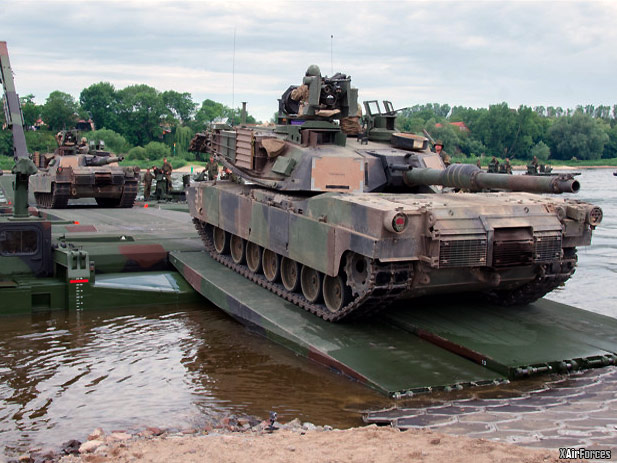
American Armour For Central Europe

US Armed Forces are going to permanently deploy equipment for an armoured brigade in Germany, the Netherlands and Belgium.
Meanwhile, rotational unit of this type is expected to be stationed in Central-Eastern Europe, it is going to maintain its presence there in a permanent manner and in its full shape.
US European Command informed the media about the reinforcement plans pertaining the units stationed in Europe. In February 2017, a full armoured brigade is going to be deployed to Europe (not just detached elements of such unit). AP outlet claims that the said element would be scattered across the NATO infrastructure of the Central-Eastern European region.
The armoured brigade which is going to be deployed to Europe is (at the moment) permanently stationed in the United States. It is going to be equipped with the latest inventory that remains at the disposal of the US Army. However, the unit will not utilize the equipment contained within the European Activity Set. The brigade in question is going to be deployed with its own equipment which is to be transported to the continent via the Atlantic Ocean.
Deployment of the equipment will serve as demonstration of capabilities of carrying out quick reinforcement of the units stationed in Europe, by the elements whose bases are located in the United States of America. Meanwhile, the equipment which remains in Europe at the moment, and which is being used by the units that periodically (not in a permanent manner, as it is expected to happen starting from the next years) remain on rotation in Europe, is going to be relocated to storage facilities in Germany, Belgium and the Netherlands.
After the relevant overhauls and modernization works are carried out, the inventory mentioned above is going to be treated as a part of “static” set which may be used by units involved in rapid deployment to Europe, should any danger arise. It shall be stressed that even though, starting from 2014, individual elements of armoured brigades were being deployed in Europe (e.g. battalion sized units, up to 1 thousand soldiers at once), beginning from the year 2017 such units will operate in a permanent manner, meaning that all the time, a US Army armoured brigade is going to maintain its presence in Europe. The equipment deployed to the Netherlands, Germany or Belgium is to remain ready, alongside with the equipment which is going to be utilized by the units remaining in Europe at the time.
Transporting the “static” set is going to make it possible to accelerate potential deployment of the reinforcement forces, should a crisis emerge. At the moment, the solutions to be applied within the scope of storing the equipment in Central-Eastern Europe remain unknown, however it cannot be ruled out that it is going to be used during the operations of the brigades that are stationed, at the given time, in Europe. This was also the original assumption of the decision, to relocate part of the equipment to the central region of Europe. The inventory was to be used by the brigades acting under the jurisdiction of the US European command at the given moment.
The rotations will last 9 months each. US forces’ presence in South Korea is being maintained in a similar way, the last of the permanently stationed brigades, whose home was located on Korean soil, has been disbanded. As we have mentioned it in our earlier analyses, the need of maintaining two permanent rotational components within at least two areas, with simultaneous operational activities being undertaken in the Middle East, will create a lot of workload which would have to be covered by the US Army armoured units. In order to maintain permanent rotation of a full element, it would be required to involve and activate more than a single unit at the time, as more assets would be needed to carry out preparations, deployment and readiness recovery.
Implementation of the plans assuming that an armoured brigade of the US Army is to be stationed permanently in Europe would significantly bolster the US military presence in the region. This would be the case especially in circumstances, in which the elements of the brigade remain active in the Central-Eastern Europe – and this is suggested by the AP outlet news, published by the Polish Press Agency. The above announcements are an effect of additional funds allocated within the US Department of Defence budgetary bill, for FY2017. They also constitute yet another signal, suggesting that the United States are making steps towards reconstruction of the deterrence potential in Europe. It shall be remembered though that even despite reinforcements come from the United States, the European states still need to provide a proper level of defence capabilities.
These countries must take steps to achieve a proper level of security, which would ensure that they will not become victims of aggression. This should be visible in increased defence expenditure, reconstruction of the conventional capabilities and reversal of the cuts implemented in some areas, throughout the recent years. The initial steps within that scope have already been taken, also in Germany or the United Kingdom, however the scope of those steps is not sufficient at the moment.
Source: By Jakub Palowski- DEFENCE24 (defence24.com) -Thursday, 31 March 2016
Photo: US Army M-1 Abrams MBTs (Photo by Sgt. Jesiah Dixon / USAREUR)
(5.04.2016)
|